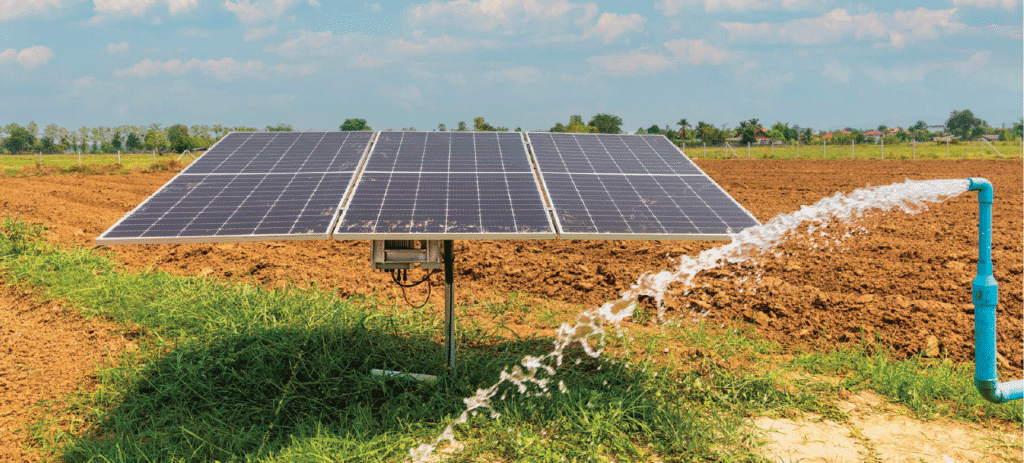A reliable water supply is the lifeblood of your farm. We’ll guide you through the technology, the critical government schemes like PM-KUSUM, and the real-world benefits of switching from diesel to solar.
For generations of Indian farmers, success has been tied to two unpredictable forces: the monsoon and the price of diesel. An unreliable grid and volatile fuel costs have made water—the most essential ingredient for a successful harvest—a constant source of anxiety and expense.
But a quiet revolution is flowing across the fields of our country. The noisy, polluting diesel pump is being replaced by the silent, clean, and incredibly reliable power of the sun. A solar water pump is not just a new piece of equipment; it’s a declaration of energy independence for the Indian farmer.
At Vecharged, we believe this technology is one of the most powerful tools for building a more resilient and profitable agricultural future. This is our definitive guide to understanding the technology, navigating the crucial government schemes that make it affordable, and choosing the right system for your farm.

The Game-Changer: Government Schemes Explained
While the benefits are clear, the upfront cost of a solar pump can be a major hurdle. This is where government schemes have become a true game-changer, making this technology incredibly accessible.
1. The National Scheme: PM-KUSUM
The Pradhan Mantri Kisan Urja Suraksha evam Utthaan Mahabhiyan (PM-KUSUM) Scheme is the flagship national program. Its goal is to make solar pumps affordable for every farmer in the country.
How it Works (The Financial Breakdown):
- Central & State Government Subsidy: Together, they provide a subsidy of up to 60% of the benchmark cost.
- Bank Loan Option: Farmers can get a bank loan to finance up to 30%.
- Farmer’s Contribution: This means the farmer’s initial upfront payment can be as low as 10% of the total cost.
| Component | Share of Cost | Financed By |
| Subsidy | Up to 60% | Central & State Government |
| Loan (Optional) | Up to 30% | Bank Loan |
| Your Upfront Cost | As low as 10% | The Farmer |
2. State-Level Schemes: Maharashtra’s “Magel Tyala Saur Krushi Pump Yojana”
You were right to ask about this. Many states have their own dedicated programs. A fantastic example is the “Mukhyamantri Saur Krushi Pump Yojana” in Maharashtra, which aims to install lakhs of solar pumps across the state. This scheme often offers even deeper subsidies, sometimes requiring farmers to pay as little as 5% of the cost, with special provisions for farmers in tribal regions.
The Vecharged Advice: Always check your state’s dedicated renewable energy agency website (like MEDA in Maharashtra) for local schemes that may offer even better terms than the national PM-KUSUM program.

The Real-World Effectiveness: Solar vs. Diesel Showdown
Is a solar pump truly better than a traditional diesel pump? Let’s look at the numbers.
| Factor | Diesel Pump | Solar Pump | The Vecharged Verdict |
| Upfront Cost | Low (₹20,000 – ₹50,000) | High (but heavily subsidized to be comparable or cheaper for the farmer) | Winner: It’s a Tie. Thanks to subsidies, the farmer’s initial cost is now on par with diesel. |
| Running Cost | Extremely High. A constant, daily expense for diesel fuel. | Zero. The sunlight is free. No fuel costs, ever. | Winner: Solar. This is the biggest financial advantage. The savings on diesel are immense and immediate. |
| Maintenance | High. Regular oil changes, filter replacements, and engine servicing. | Extremely Low. Occasional cleaning of the solar panels is all that’s required. | Winner: Solar. A solar pump is a “fit and forget” technology that saves countless hours and rupees. |
| Reliability | Dependent on fuel supply. Prone to mechanical failure. | Extremely High. Works every day the sun shines. | Winner: Solar. Provides unparalleled energy security and peace of mind during the crucial irrigation season. |
How to Implement: Your 3-Step Guide to Getting a Solar Pump
- Sizing Your System: The “right size” depends on your water needs. The key metric is the pump’s capacity, measured in Horsepower (HP). A 3 HP or 5 HP pump is common for most small to medium-sized farms. The solar panel array will then be sized to match the pump (e.g., a 3 HP pump requires roughly a 3 kW solar array).
- Choosing the Right Components:
- The Pump: A submersible pump is required for deep borewells. A surface pump is used for sources like ponds, canals, and open wells.
- AC vs. DC Pumps: Most modern kits use highly efficient DC pumps, which are the standard for PM-KUSUM.
- Applying for the Scheme:
- The first step is to visit the official portal for your state’s renewable energy development agency or the national PM-KUSUM portal.
- You will need to register and provide documentation like your land records (7/12 extract), Aadhaar card, and details of your water source.
- You can then choose from a list of government-approved vendors who will handle the installation.

Top Solar Pump Brands in India
When choosing a system under a government scheme, you will select from a list of approved vendors. Some of the most trusted and widely available brands in the Indian market include:
- Tata Power Solar: A giant in the Indian solar space with a reputation for quality.
- Shakti Pumps: One of the largest manufacturers of solar pumps in India.
- Luminous Power Technologies: A well-known brand in the inverter and battery space, they also have a strong presence in solar pumps.
- Crompton: A legacy brand in India known for its reliable motors and pumps.
- Waaree Energies: A major solar panel manufacturer that also offers complete pumping solutions.
Our Final Word: An Investment in Your Farm’s Future
A solar water pump is more than just a piece of equipment. It is an investment in your farm’s profitability, your family’s future, and your own energy independence.
With the powerful support of government schemes like PM-KUSUM, the financial barrier has been removed. By breaking free from the endless cycle of rising diesel costs, you are not just irrigating your fields; you are cultivating a more resilient, profitable, and sustainable future for generations to come.












